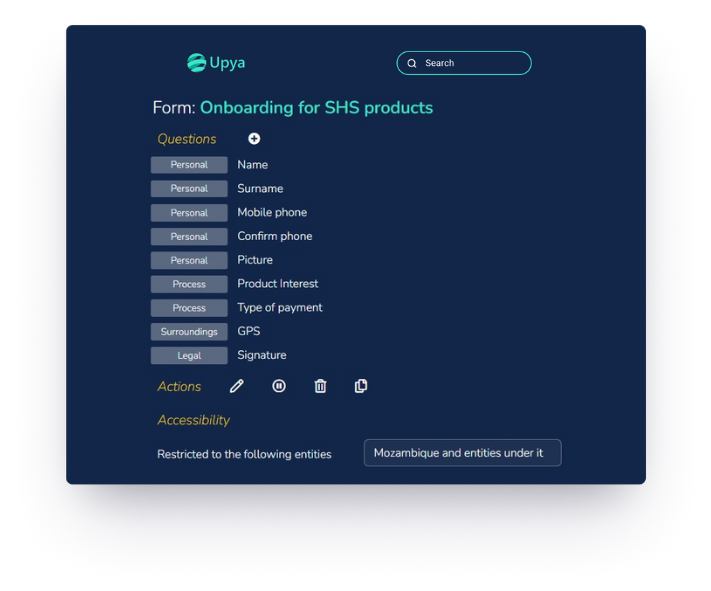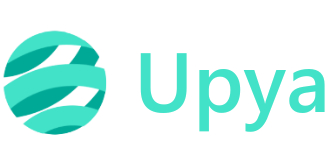Particularly it is true when it comes to streamlining Monitoring, Reporting and Verification (MRV) processes. Despite the benefits, the widespread adoption of digital survey tools is hindered by challenges in usability and intelligence. To enhance the digitization of data collection, the tools must be user-friendly and comprehensive. This will allow carbon credit project developers to easily create and deploy questionnaires that improve survey performance by agents.
Table of Contents
No-code Questionnaire Builder
Upya Collect provides a no-code questionnaire builder featuring path-dependent logic and over 15 question types, including options for capturing signatures, pictures, GPS coordinates and more. This web-based desktop application has an intuitive interface, allowing users to easily create digital surveys without using Excel.

Intelligent Digital Data Collection Features
Additionally, Upya offers several powerful and intelligent data collection features to enhance data accuracy and integrity:
- Scan-type questions: assist in allocating the correct unit serial numbers. They are commonly used by cookstove project developers in standard sale surveys to ensure clean data collection at scale. Today scan questions allow the mobile app user to scan QR or barcodes, NFC tags and even read bluetooth linked data.
- Drop-down lists: provide selectable options tailored to field agents, reducing the chance of human error. These types of questions (selectable standard/with options/from objects) are widely used in carbon credit projects for both pre-sales and after-sales surveys, ensuring compliance with methodologies like Gold Standard and Verra. Additionally, drop-down lists can include conditional options. For example, if a question asks “Do you use a cookstove?” and the answer is “Yes”, the next question could prompt “Please specify the type”.
Drop-down lists can also be made up of “Objects”. Objects serve to call upon an existing and dynamic data set, such as the list of clients, agents, assets and so forth. By including “objects” into a question, the list of available options is therefore always the latest, without having to continuously renew included items. It ensures that the field staff is given at all times the most updated lists to select from. - Path-dependency: offers advanced options for creating questionnaires. You can set questions as mandatory, require unique answers, link them to previous answers or use them as pivot questions that must be answered before proceeding. These options are particularly useful for managing large baseline surveys with 50+ questions, ensuring that agents can work efficiently. For example, “Are you using charcoal for cooking?” can be a pivot question that prevents agents from moving forward until it is answered.
- Action-type questions: can automatically trigger tasks for field agents during usage or impact surveys. For example, if a problem is reported by an end beneficiary or if there is a payment issue, an action-type question can trigger an automated task to repossess the unit.
- Weighted scoring: helps validate prospects and markets during pre-sales baseline surveys. Project developers can assign weights to questions and their answers. After the beneficiary completes the survey, a total score is calculated. The score can be used for example for an automated approval in an onboarding process or simply to calculate a score required for categorisation of beneficiaries or usage patterns.
Web-based Friendly UI for Forms Creation & Analysis
The UI is web-based and does not require the use of Excel, simple and user-friendly, making form creation and analysis easy to use for both standalone and client-linked forms:
- Forms can be restricted by Entity (project, country or implementation partner) or Agent, which is crucial for maintaining high-quality and high-integrity carbon credits claims.
- Accessibility settings can also be configured for internal audits and external verification by Validation and Verification Bodies (VVBs) with a bulk download option.
- Helper codes are designed for longitudinal data collection on existing clients or end beneficiaries. The Helper codes feature supports updating client profiles with new survey responses. For instance, if a client’s picture is updated in a survey using the “ClientPicture” Helper Code, their profile will reflect the new picture.
Upya’s Field Solutions for Carbon Credits
Leveraging extensive industry expertise, Upya Collect consolidates all essential data collection features into one comprehensive platform to improve the MRV process. Its user-friendly web and mobile apps enable carbon credit project developers and their field agents to collect data efficiently. As a result, Upya simplifies MRV processes and ensures data accuracy and integrity, leading to high-quality carbon credit claims and fostering greater trust and investment in sustainable projects. Learn more
